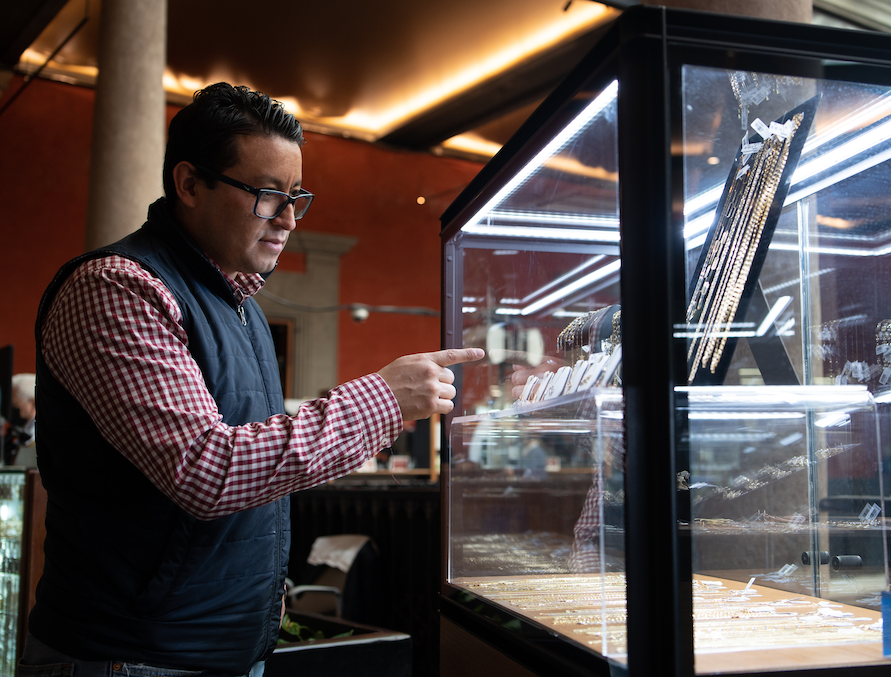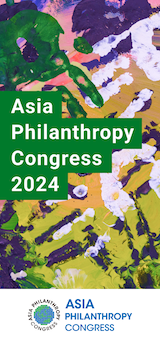The idea of a social purpose pawnbroker might seem odd, but it has a long history in Mexico’s Nacional Monte de Piedad. Social Investment director Alejandra Angarita Chahín explains to Andrew Milner how it works.
A virtuous circle of aid
Andrew Milner: What are the origins of Monte de Piedad in Mexico?
Alejandra Angarita Chahín: It was founded in 1775 by Pedro Romero de Terreros, at that time the richest man in Mexico. He came originally from Spain, so he came with the European tradition and the original Monte de Piedad’s model, which began in Italy, in mind. The idea was to give people cash or credit in return for a pledge which they paid interest to redeem. He thought it was needed at that time because many Mexicans needed money to finance agricultural, livestock and mining projects, among others.
When did you start paying the interest to civil society organisations? Because there are really two sides to this model – those who make the pledges and benefit from the loans, and those who get the benefit of the interest.

Alejandra Angarita Chahín. Credit: Monte de Piedad
At the time Monte was founded, NGOs didn’t exist, but Monte already had the aim of helping people who couldn’t get access to the loans or any financing option for that matter, so part of the interest was donated to the poorest people in Mexico City. I don’t know how much because we only have a few records from that time. In the 1920s, Monte got the status of Institución de Asistencia Privada, which is the legal status Mexican NGOs have. By that time, we had around 10 pawn shops around the country and each of them could give money to whichever organisation they decided to support.
In 1990, we started doing calls for proposals, and I think at that time we supported around 200 organisations, but we didn’t have a strategy or social model. Then, in 2010 we did the first evaluation of our work in social investment. From that, we figured out that if we gave the organisations more than grants for projects, but money to strengthen the organisation, they would get better results. At the time, we were supporting a real mix of organisations – food security, health, decent work, childhood support, and every one was a good investment, but to increase the social return, we knew we had to strengthen the organisation.
Further evaluation showed us where we could best intervene was to support organisations working to ensure employability, high-quality education and decent jobs for young people, for women and for groups in vulnerable situations. So at that point, in 2017, we decided to focus part of our social investment and prioritise education, employability, decent work, entrepreneurship and financial inclusion.
Roughly what amount of money do you assign to each of those areas?
I think the whole budget from social investment is 20 million dollars a year, and 35 per cent of that money goes to education, 20 per cent to employability, entrepreneurship, decent work and financial inclusion and the other 45 per cent goes to healthcare, security and support generally for excluded communities like Indigenous people and communities in extreme poverty. Last year, we supported 548 organisations in those areas. Every year, it’s roughly the same number.
In 2017, we decided to focus part of our social investment and prioritise education, employability, decent work, entrepreneurship and financial inclusion.
Do you support the same organisations or is it different each year?
We usually make a call for proposals and then assess if they have the capability to make their programmes scalable, to do public advocacy, or to provide quality services to the poorest people in the country. We have three big steps in the selection process; the first is to check that the organisation complies with the legal and tax regulations in Mexico.
The second step is an evaluation to understand how their programmes work and if they are well designed: do they do monitoring and evaluation, do they work with people other than the direct beneficiaries – other partners, local governments or with enterprises or other educational centres, depending on the topic? Our methodology for this is based on the OECD’s methodology which promotes design, planning and evaluation processes towards the generation of sustainable solutions to resolve social problems in such a way that people in vulnerable situations are part of the solution and are not just passive recipients. So we conduct this process with all the organisations we work with every three years, but also for each new organisation applying for a first grant with Monte. If they are more focused on charity, we say ‘sorry, those aren’t the kind of services we fund’.
The final step is that they present to us a project and a budget, which we assess and on which we make a grant. Then, every year we have a group of organisations that we already know do a great job – they are guest organisations, invitadas. They have to present a project every year, but they don’t have to compete for the resources. They have a pre-authorised grant.
So you don’t make grants over, say, five-year periods?
It could be the same project, but we need to make the approval every year because we don’t have an endowment to support multi-year investment. However, from 2020, we started looking for grants from other donors and co-investors from the US, such as the Hilton Foundation, Pepsico Foundation, among others, and from Latin America who wanted to invest in Mexico, and we found a lot of interest in our educational and decent work agenda, so several donors have decided to give us multi-year funding so we can make multi-year investments with that money. Twenty per cent of the grants that we made last year were from other donors.

A Monte client selects an item of jewellery. Credit: Monte de Piedad
Obviously the model is that people come and bring things to pledge, you lend them the money on that and they pay back with interest. But presumably you have the money in the first place to give them when they come and make the pledges?
Our principal income is from the interest on the pawn loans. We have a huge market in Mexico. In 2023, Monte de Piedad delivered 7,203,993 pledge loans, with a portfolio value of 28.370 million pesos, equivalent to $1.669 million. Once the costs of this pledging operation are covered, part of the surplus is used to guarantee the long-term sustainability of Nacional Monte de Piedad, and another part is used for social investment. Six years ago, Monte de Piedad bought a financial institution to modernise financial services for those who need them most, as the market for pledge loans is shrinking. In the past, it used to be principally objects in gold, whose value was more stable, but today it’s more electronics, cars, computers and so on and their value depreciates rapidly. One of Monte’s aims is to exist in perpetuity and that’s why Monte decided to buy this financial institution, which will deliver digital services for financial inclusion, savings accounts and remittances and, again, the profits from that financial institution will be used partly to sustain Monte and to support the full exercise of social, cultural and economic rights of people in poverty through social investment.
What are the main problems that philanthropy in Mexico is trying to address?
We have low-paid, low-quality jobs and six people out of every 10 in work don’t have access to social security or to health insurance. That’s over 60 million people. So the main challenge is the quality of jobs. Second, companies complain that Mexicans don’t have the qualifications or the knowledge or the experience they need to get a good job because education is very poor. The main challenge here is the quality of education and its accessibility in terms of cost, not the quantity of programmes or universities. The problem starts in the early years of education where children do not develop the basic skills and learning for their educational development.
Obviously these are the areas that you’re working on at Monte de Piedad. Do you see other philanthropists in Mexico working in the same areas?
Yes, we have two allies and we designed together strategies to co-invest in that agenda. One is Fomento Social Citibanamex, a big donor in Mexico, and the other one is Fundación Coppel. I think that we are the three donors most interested in the decent work agenda. There are other big donors more focused on education like Fundación Gonzalo Río Arronte and Televisa Foundation and the Carlos Slim Foundation. But, for the size of the problem, we are few donors. That’s the reason donors from other countries are interested in co-investing in this kind of agenda.
It’s not about giving money, it’s about working with allies and with the people in poverty to create solutions that allow them to access opportunities and empower themselves.
Generally speaking, do you see more awareness among philanthropists in Mexico of social problems?
In general, philanthropy in Mexico is traditional. Philanthropists prefer to support a community or specific group of people: community kitchens, schools, grassroots organisations, or religious organisations that perform their social work by providing food, clothes, educational support, health services, etc. Mexico is a country with a lot of poverty, and that type of organisation is necessary and they are what Mexican donors prefer to support. People want to feel that they are doing a good job by providing the material resources that poor people need, but for us, it’s not about giving money, it’s about working with allies and with the people in poverty to create solutions that allow them to access opportunities and empower themselves to achieve a healthy, dignified and active civic life. In Mexico, there are currently various spaces for reflection among donors and philanthropists about the role of philanthropy in Mexico – CEMEFI Donors Forum, RedEAmerica Nodo Mexico, PulsoOSC, Nuevo León Donors cluster, among others – where new ways of doing philanthropy by collaborating with others to achieve greater and deeper impact are being explored.

Programme for deaf schoolchildren run by Monte-supported social organisation IPPLIAP. Credit: IPPLIAP
In Europe pawnbrokers have a bad reputation as exploiters of the poor and the needy. Obviously your model is different but do you ever come across that attitude?
Pawn shops have a very poor image in Latin America, too. The image is that they are taking advantage of poor people by charging a high rate of interest for loans. Monte de Piedad has three mandates; the first is to combat usury. The second one is to be perpetual and the third is to combat extreme poverty in the country. When I joined, I was curious about how we could combat usury while making pawn loans. Our virtuous circle of aid charges the lowest rate of the market, not only compared with financial institutions, but also with other types of informal credit such as credit circles, where a group of people get together, pool their money, and then decide how to lend it. Interest rates range between seven and 12 per cent a month. That’s more than double the interest rate at Monte de Piedad which only charges between three and five per cent and we encourage people to pay back within five months, because after that, it becomes costly for the family. This is one way to combat usury. Evidence of this is that in 2023, Monte served 1,162,000 clients, of whom 80 per cent recovered their pawned items. And finally, in the case of clients who lose their pledge, Monte sells the pledge, recovers the money owed and returns any extra to the pledger.







Comments (0)